SNEC E-magazine
Rendezvous with Darjeeling
Abhijit Poddar Dept. of Electronic Science
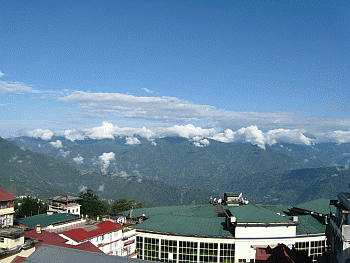
a view from our hotel terrace.
The prelude
The summer recess had commenced. However, I had only a week to myself before getting busy with examination related duties. It would be nice, I thought, to make a short trip to somewhere outside Kolkata and get reenergized for the coming academic session. Puri, Digha, Mandarmani were a few places that I had in mind to choose from. But they were vetoed down by my better half, with active support from my son, on the pretext that they would be just as hot and unpleasant as Kolkata during this time of the year. It was then that the name of Darjeeling cropped up. The weather in Darjeeling would be nice and cool and given the fact that it could be reached in less than twelve hours from Kolkata, made it a very good choice for a short trip. So there I was, sitting in front of my computer, frantically looking for available berths on the 'Darjeeling Mail' through the Indian Railways portal. Unfortunately, there were none! Not only on 'Darjeeling Mail', but on all the other trains from Kolkata to New Jalpaiguri station in the next few days. That was a real dampener! I suggested we drop our plans and go somewhere else. My son, however, would have none of it. So, I got back to my computer, started googling and came to know there were overnight bus services from Kolkata to Siliguri. Next morning, we visited the Esplanade bus depot and booked three seats on a Volvo bus for our journey to Siligri that very evening. We still had to book our hotel rooms, though! Back home, I searched the web for hotels in Darjeeling, found the contact phone numbers and email addresses of a few of them, and spent the next hour or so trying to arrange for some accommodation. After many attempts, I was able to make a telephonic booking for a room in a hotel close to the 'mall' (more about the 'mall' later). With the bus tickets in our hands and accommodation more or less confirmed, we got down to packing our bags. It was five pm when we hailed a taxi and off we were to catch the bus departing from Esplanade.
Bon voyage
The bus left the depot precisely at seven pm. It was a long, overnight journey to Siliguri. The roads were smooth and wide, except for a few stretches where they suddenly became narrow and ridden with potholes. The ride, however, was comfortable, courtesy the good shock absorbers, the spacious reclining seats and the ac, which seemed to work fine. In between we watched the Hindi movie 'Dabaang' on the LCD screeen, with bad cop Salman Khan dancing to the lines of 'Munni Badnam Hui..' before delivering justice in his own imitable style. Late at night, the bus made a scheduled stop at a roadside eatery where we had our dinner of freshly made rotis, egg-curry and tarka. We slept through the remaining hours and by early morning we were closing on to our destination at Siliguri. It was around seven am when the bus reached the Siliguri bus terminus. The terminus had reasonably clean toilets with running water. We brushed our teeth, freshened up and treated ourselves to a breakfast of fresh pastries and hot coffee at the Monginis outlet inside the petrol pump adjacent to the terminus. We were now ready for the last phase of our journey: a ride up the hills to Darjeeling town.
The climb
A Tata Spacio, which looks similar to its older cousin, the Tata Sumo, was waiting at the roadside next to the bus stand with the label 'DARJEELING' stuck to its windshield. We booked the whole of the middle row, a set of four seats for the three of us and our handbags. Our only suitcase was put on the roof, securely tied and covered with a plastic sheet to prevent it from getting wet, should it start raining. Around ten am we were off. The driver was a short, yellow complexioned Gurkha, a native of Darjeeling. His English was halting but understandable. As long as we were on the plains (foothills to be precise), the road was wide and smooth, with beautiful tea gardens and forests on both sides. However, once we started to climb up the hill, the road became narrow, meandering and treacherous.
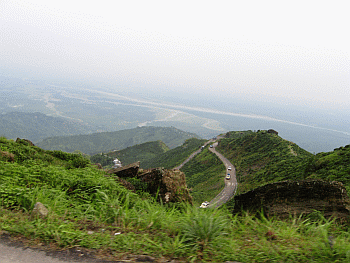
Unfortunately, I belong to the class of few who are said to suffer from a fear of heights. On top of that, this was my first visit to a hill station. I held on tightly to the handle atop the front seat as I watched petrified, our car whizzing past other cars coming from the opposite direction on the narrow and steep road. What was more shocking was the fact that the driver was not taking his foot away from the accelerator pedal, even when making the sharp 270-degree bends on the steep road. I was feeling real sick by the time we reached Kurseong around noon. Fortunately, the remaining stretch of the road was wider, better maintained and less steep, as a result of which I could enjoy the beautiful sights of the hills without the thought of our car plunging down the hill haunting me for the rest of the journey.
Arrival at Darjeeling
We reached Darjeeling around 1 pm. We were dropped near the Darjeeling railway station. On querying the locals, we came to know that our hotel, near the 'mall', was further up. Fortunately we got the services of a lady porter, who used a thick rope tied to her head in a unique way, to haul our suitcase and bags up to our hotel. Since I had only made a telephonic booking of our room at the hotel without making any advance payments, I was a little apprehensive about actually getting hold of the room. But to our nice surprise, the lady at the reception took little time to make the mandatory checks and handed over the keys to our room with a pleasant smile. Once inside, we took our bath, put on fresh clothes and ordered our lunch. Hungry and tired as we were, we gorged on the food (chicken curry and tandoor rotis) and went off to sleep in no time.
Walk around the 'mall'
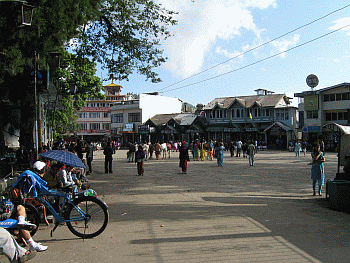
It was around four in the afternoon that we woke up from our nap. The sun was still shining. The weather was cool and pleasant. We wasted no time in getting out and going for a stroll around the 'mall'. The 'mall' happened to be a big open courtyard surrounded by quaint shops and hotels on one side and imposing hills on the other. There were tourists from India and abroad, as there were locals young and old, strolling under the lazy sun. There was a beautiful pathway leading from the 'mall', going around a hillock and joining the 'mall' again.
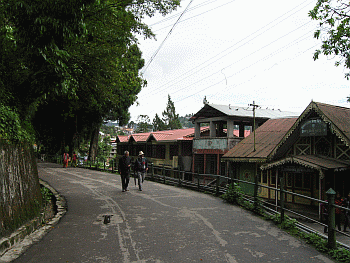
We took a walk on this pathway, which had rows of wooden houses on one side, with beautiful gardens and flowers in full bloom. Further down the pathway, we came across a couple of vantage viewing points. At one such point we had a spectacular view of huge hills, lush with greenery, with clusters of small houses nesting in the valleys. White clouds floated leisurely, obscuring the view at times. A school for little children was located nearby. School had just ended for the day, and little boys and girls trooped out in their nice uniforms, laughing and playing with unabandoned glee.
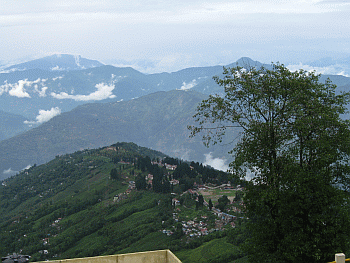
As dusk set in, it started to become cold and we headed back to our hotel. We decided to go out for dinner though, around 7 pm. There were scores of restaurants offering a wide choice of cuisine (Chinese, Mughlai, Bengali, Continental) on the road leading to the 'mall'. We picked one arbitrarily and had our fill of authentic Chinese food. We returned to our hotel and went to bed early.
Bandh on day two!
Day two of our stay in Darjeeling started on a poor note with the news that the dominant political group in the hills had called a strike. All shops and establishments were to down their shutters for the day.
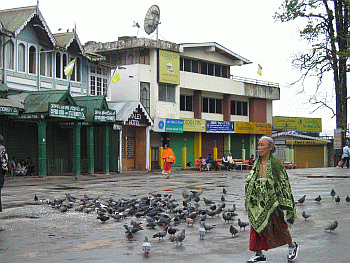
There was no restriction on the movement of tourists though, and so we ventured out to the 'mall' in the morning. Except for a flock of pigeons feeding on scattered rice and a few locals, there weren't many people around. Rest of the day, we remained couped up in our hotel rooms watching cable TV. We did not have to go hungry though, as luckily for us, food was arranged for by the hotel staff. In the evening, we contacted a travel agency next to our hotel over the phone and booked a Tata Spacio to go on a sightseeing tour of places of interest around Darjeeling. The vehicle was to arrive at our hotel doorstep at 3am in the morning to take us up the Tiger Hill to view the sunrise over Kanchenjunga peak. We set the alarms in our mobile phones and went to sleep.
Sightseeing tour on day three
We woke up at 3 am the next morning, only to receive a call from the travel agent we spoke to last night, informing us that the sunrise would not be visible because of unfavourable (cloudy) weather. My disappointment was laced with a little relief as I could now enjoy a few more hours of much needed sleep. We finally woke up around 7 am, had a hearty breakfast provided by our hotel and were ready by the time the Spacio honked in front of our hotel door. The driver and his assistant, both young twenty-something lads were to be our tour guides too, as we were to learn soon. Our first destination was to be a climb up the Tiger Hill. However, the weather was cloudy with rain threatening to pour down anytime. So we proceeded to visit the Japanese temple and Peace Pagoda, located close to each other and surrounded by lush green pine and other trees that accentuated their spiritual appeal.
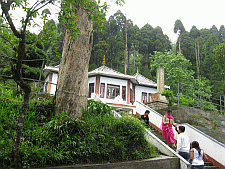
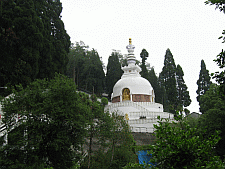
Our next destination was the zoo and the Himalayan Mountaineering Institute (or HMI) located within the zoo compound. The tickets to both the places were to be bought at the entrance to the zoo. The zoo was small but unique. It housed among others, animals which roamed the forests and hills in the region like the mountain goat and the snow leopard, to name a few. The HMI had a wonderful museum containing memorabilia from Tenzing Norgay and Edmund Hillary's first successful attempt to conquer Mount Everest. It also had a collection of accessories, like special boots, oxygen masks, sleeping bags, special suits etc used by mountaineers. There was also a model of the different Himalayan mountain ranges with their important peaks like the Everest and Kanchenjunga. To locate a peak, one could press a switch having its name and observe a light flashing beside the peak in the model. Needless to mention, it kept my son preoccupied for quite some time, during which I could read the detailed exploits of the famous and brave mountaineers of our country, undisturbed. By the time we were done with HMI, it had started raining heavily and we had no option but to wait under a canopy for the rain to stop.
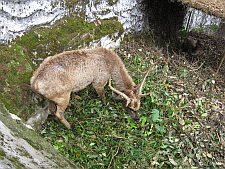
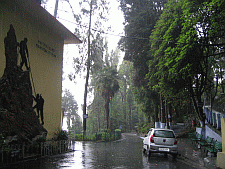
Once the rain subsided, we took off to visit the Tibetan Refugee Camp perched on top of a hill. On the way, we went past a huge rock by the roadside on top of which were standing young people, trying to learn the nuances of rock climbing from the experts from the Himalayan Mountaineering Institute. The road to the refugee camp was steep and narrow and soon we were caught in a traffic jam of sorts. The refugee camp was a cluster of a few buildings, one of which was a showroom selling authentic artefacts, dress materials, scarves, shawls, carpets, wall-hangings etc made by the Tibetans refugees themselves. And one thought that Tibetans in India resided only in Dharamsala in Himachal Pradesh!
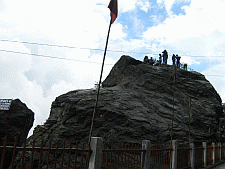
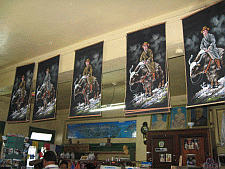
Thereafter we proceeded to have a glimpse of a tea garden from close quarters. Tea is made from the leaves of a small, bushy tea plant. Scores of such tea plants adorn the slopes of a hill and constitute what is known as a tea garden.
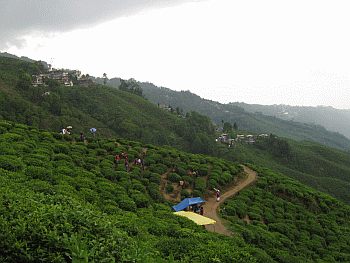
Women wearing traditional attire were plucking tea leaves and putting them into the baskets behind their backs with the tourists busy clicking their cameras. There were a number of stalls on the roadside selling fresh Darjeeling tea. Customers could order a freshly made cup of tea, savour the flavour, and then decide upon which tea to buy.
Next, we drove through the congested markets of the city to reach the Ava Art Gallery. I must confess that I am not a big connoisseur of arts and was not too keen to go inside, more so as the building looked staid from the outside. On retrospect, it would have been a tragedy of sorts, had I missed viewing those very intricate threadwork over fabric to give astonishing three-dimensional perspective to a human face. Shooting pictures was prohibited, as was to be expected. One could however buy her artworks, prices of which ranged from 2000 rupees to a lakh.
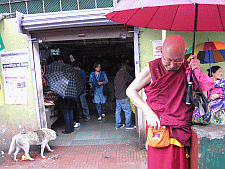
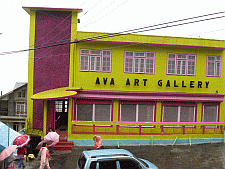
Thereafter, we set forth for a trip downhill to visit the Rock Garden and the Ganga Maiyya Park. The road was very steep, with a negative gradient of 45 degrees at some places.
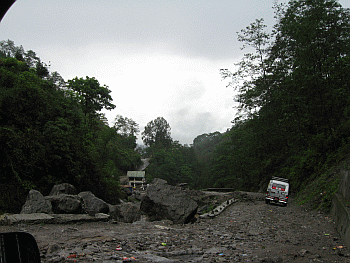
It was also in a very bad shape. As we travelled downwards, the hills on both sides of the road seemed to grow in size ...as if we were spiralling down an infinitely deep well, not sure if we would come out again! As we reached the Rock Garden, we were told by our driver and his companion that a big landslide had hit the area last year, destroying many stalls that catered to the tourists. No lives were lost though. Maybe it was a blessing in disguise, as, bereft of the ugly stalls, the place looked stupendously beautiful. Brown, murky water flowed down the hills, creating slithering rivulets and roaring waterfalls.
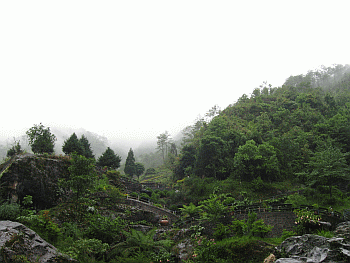
There were quaint wooden bridges across the streams and stairs carved out of the rocks so that one could walk up the hill and enjoy a great view from there. We only had time for a quick lunch, momos and chowmein to be precise, at a small food outlet at the bottom of the garden. From there we went on to visit the Ganga Maiyya Park, which again had beautiful flowers, variety of trees, an artificial lake for boating, and good food joints. Unfortunately, it had closed by the time we reached the park. However, our driver seemed to know the gatekeeper, who was kind enough to allow us a little stroll through the park.
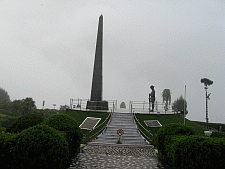
We took the same tortuous road uphill until we reached the smooth and bigger road that would take us to Batasia Loop. It has a war memorial, a garden, a track for the toy-train to go round and opportunity to savour some breathtaking sights of the Himalayan mountains. Unfortunately, we were greeted with a thick cloud cover and a drizzle. We could do no more than take a few snaps of the war memorial and leave for a ride to the Tiger Hill.
The road that was taking us to the top of tiger hill was desolate and flanked on both sides by huge trees and dense foliage. A veil of mist was gradually engulfing the hill, reducing the visibility to a point where it was becoming difficult to see beyond a few meters. Darkness was setting in fast. It was an eerie feeling. The name of the hill had something to do with it too, I guess. I requested the driver to turn around and take us back. On the way back, the cloud-cover somewhat lifted and I could take a few shots of the scenery around.
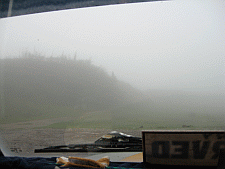
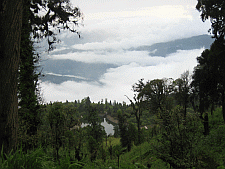
We passed by the Ghum railway station, which is statistically the second highest railway station in the whole world. Our tour ended on a somewhat spiritual note with a visit to the Ghum Monastery. The monastery was closed, as it was late evening. However, a monk allowed us to enter and have a glimpse of the prayer room, which housed the spiritual urns.
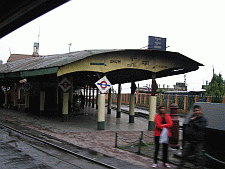
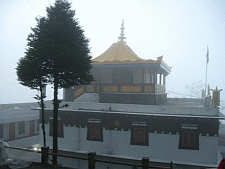
At the end of it all, we were dead tired and after an early dinner retired to our room, watched a game of the Indian Premier League on TV for sometime before dropping off to sleep.
Our last day in Darjeeling
The sharp rays of the sun coming through the gap between the heavy curtains of our hotel room woke me up, a tad earlier than I am used to. It didn't take me long to realize that it was a sunny morning, as opposed to the cloudy and rainy ones that had greeted us the preceding days. I jumped out of the bed, got hold of my camera, and rushed up to the top floor lounge. As I looked out of the big window, I was greeted with the view sought by everyone coming to Darjeeling and which had eluded us so far because of the weather: that of the majestic KANCHENJUNGA, resplendent in all its snow capped glory. I took a few shots as quickly as I could, went down to my room, returned with my wife and son, enjoying the sight together for a few more minutes, before the unforgiving clouds drifted across and blocked the view. We were not complaining any more. The next few hours were spent shopping for a couple of woollen sweaters and jackets, caps, colourful umbrellas and a few gifts for our relatives back in Kolkata.
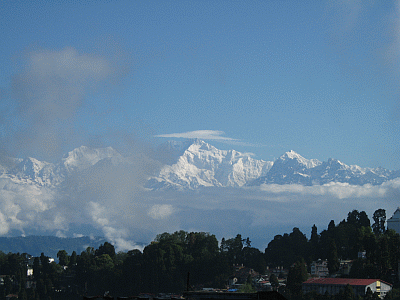
Back to Kolkata
Around 1 pm we bid adieu to Darjeeling, taking a 'shared taxi' ( a Tata Spacio) to Siliguri. In the evening we boarded another Volvo bus, from outside the main bus terminus and our journey through the night was predictably uneventful. We reached Kolkata and our home early next morning. The excitement of having returned from a very enjoyable trip showed in the way my son narrated our experiences to his grandparents. I too have not stopped sharing my stories of the trip with my colleagues in college. There has been, though, one regret: that of having missed seeing the sunrise atop Tiger Hill. Maybe, we need to make another trip to Darjeeling soon. Preferably, in the winter, to experience the snow as well. That would be so exciting!
P.S. All the photographs you see above have been taken with a Canon point and shoot camera and resized for optimal viewing on this page.